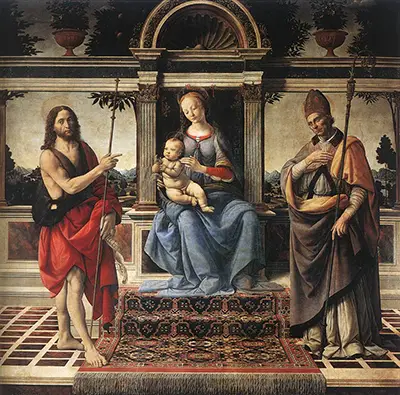The Pistoia Cathedral in Tuscany is the home of an interesting piece of work by the Italian artist Andrea Del Verocchio.
The painting was to be an altarpiece for the oratory of Piazza Madonna, and is now situated in the Chapel of the Blessed Sacrament which has become known as the Chapel of San Donato. This is due to the influence of the image of the Madonna Enthroned with St. John the Baptist and St. Donatus which is featured on the right hand wall of the chapel.
As with many paintings of this era, it was commissioned by one of the Medici family - namely Donato de Medici - and although started by Verocchio in 1474 it remained unfinished until later completion by a different artist, Lorenzo di Credi, who had served as one of Verocchio's studio assistants and who played a large part in developing the painting. The first part was completed in 1479 but the second stage was not re-started until 1485 due to lack of funds for payments, and the final version was finished in 1486. The painting was intended to show the name saint of the Medici family member it was painted for who was also a bishop. Therefore, the representation shows Saint Donatus of Fiesole to the right of the Madonna.
The image of the Madonna Enthroned with St. John the Baptist and St. Donatus is of a pictorial style and is composed of a tempera on panel technique. Tempera is a type of painting that is used with pigments dispersed in an emulsion mixture and this would often be egg yolk. The technique dates from around the 12th century but was still in use in the 15th century in Europe and continued to be used until oil paints began to take precedence. In it's original form the painting had a predella with a number of other painted panels, however, these have now been distributed amongst a number of different museums, one of which is in Worcester Art Museum and which depicts St Donatus and the Tax Collector.
Like a number of his contemporaries during this era, Verocchio was born and raised in Florence where he worked as not only a painter but had skills as a goldsmith and sculptor, and he is most famous for the latter talent with his Equestrian statue of Bartolomio Colleoni in Venice which is generally considered his greatest work. His paintings were not as widely known or clearly identifiable in some cases. However, he had some notable pupils in Leonardo de Vinci and Pietro Perugino, and it thought that Verochhio's influences can be seen in some of Leonardo's artistic works including a particular twisting pose of the human form known as figura serpentinata.
It is thought that Verocchio could potentially have trained as a painter with Fra Filippo Lippi but this cannot be fully verified, and some of his paintings are difficult to differentiate from those of the early work of artists such as Botticini and Peregino. However, the Madonna enthroned with St. John the Baptist and St. Donatus can be attributed to this artist at least in part one of it's development, and is a testament to a particular style of painting still prevalent in the 15th century.




